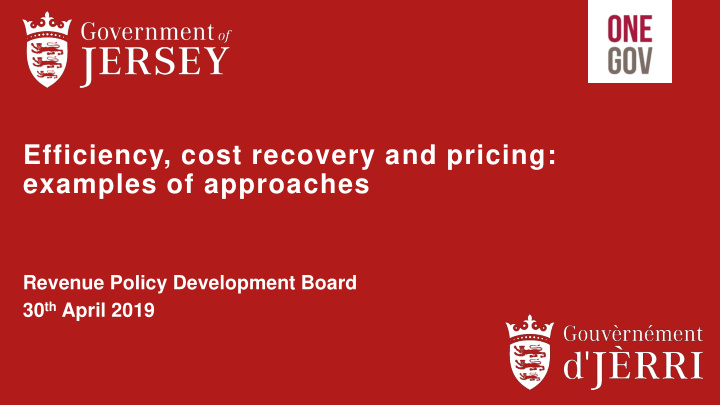



Efficiency, cost recovery and pricing: examples of approaches Revenue Policy Development Board 30 th April 2019
Purpose • Set out strategic approaches to costing, pricing and charging • Illustrate a framework for developing a strategic approach • Take steer and direction from the Board on next steps Structure • Set out approaches to costs and pricing (20 mins) • Group up discuss cussio ion n (20 mins) • Next steps (5 mins)
Approaches elsewhere
Cost, price and charging framework Our Approach & Methodology A five-staged approach 2 3 4 5 1 Define strategic objectives of the Develop robust Consideration of Scoping / Develop new product or service understanding of factors which may understanding the pricing and (e.g. policy, cost of delivering influence pricing current picture charging approach behavioural, product or service decisions commercial) Scoping the current Each service to set Determine the degree to Consider factors such as Applicability of different picture of fees and political, behavioural, which cost recovery is to political sensitivities, pricing strategies which charges across commercial objectives be achieved and ensure market competition, achieved predetermined Departments firm justification where customer segregation strategic objectives, it is not achieved. etc. which may have including: • Any issues or technical positive or adverse Cost based • constraints which need Utilise this step as an effects on pricing Competition based • to be taken into opportunity to assess decisions. Demand based consideration, which the efficiency of the affect the areas in scope delivery model.
STEP 1 1 SCOPING PRODUCTS & SERVICES
Cost, price and charging framework STEP 1: Scoping products & services Product/Service X Issues for consideration and Categorising current charges by technical constraints function Type of product/service Appropriate benchmarking Resource Outcome Statutory Law/legislative Further review of product / service Place Financial Direction Discretionary Customer impact People
STEP 2 2 DEFINE STRATEGIC OBJECTIVES
Cost, price and charging framework STEP 2: Define Strategic Objectives Strategic discussion about policy, behavioural and commercial objectives for (a) Government as a whole (b) particular service. Note – basket of objectives may apply; not necessarily mutually exclusive • Generating a higher level of income for the purpose of either investing back into the product Fund Investment or service to improve it or into another area of focus • Control of access through encouraging or discouraging use of a product of service e.g. Influence Public Behaviour encourage recycling or reducing car use. Respond to Competition • Considering a change in price to respond to recent market activity Deliver policy priorities Influence behaviour Increase Customer Retention • Increasing revenue through increased market share or repeat customer business Develop a new Customer • Is the Government considering entry into a new market or introduction of a new product / Base service • Improving the quality of the product or service to drive customer satisfaction, having the Improve Customer Service potential to increase uptake and / or retention • Increasing the productivity and efficiency of delivering the product of service i.e. better Increase Productivity resource allocation, economies of scale, cost reduction. • Generating a higher level of income through greater volumes of product sales or increased Drive Revenue Growth use of service (both in terms of frequency and customer base). • Increase profitability through better cost management, increasing turnover, increasing Increase Profit Margins productivity, and increasing efficiency. • Ensuring there is value derived from every purchase of product or use of service for money Ensure Value For Money spent. This includes efficiencies as well as cost. Introduce New Products • Is the objective to introduce and establish a target audience for a new product or service or (New & Existing Markets) an existing product or service into a new market.
STEP 3: 3 EXPLORE COSTING METHODOLOGIES
Cost, price and charging framework STEP 3: Exploring Costing Methodologies Many approaches to derive costing – appropriateness will be determined by the product/service in question 1. Activity 2. Target 3. Direct 4. Standard 6. Process 5. Job costing based costing costing costing costing costing • Matching overhead • Costs that are • Costs that are • Creation of • Production costs • Costs for processes, costs as closely as expected to be directly associated predetermined costs attributable to which involves possible with incurred and how with changes in to approximate specific units or homogenous organizational this will impact the production volume actual costs groups of units products or services activities viability of the product or service
STEP 4 & 5: 4/5 PRICING INFLUENCES & STRATEGIES
Cost, price and charging framework STEP 4 & 5: Pricing influences & Strategies Many factors influence pricing – some are There are various strategies for pricing, depending on the commercial and strategic objectives more within our control than others Examples of pricing influences Examples of pricing strategies Competition- 1. Government objectives Demand-based Cost-based based 2. Available Information Penetration pricing Cost-plus pricing Bundle pricing 3. Competition Rate based pricing Competition pricing Value based pricing 4. Customer Skimming pricing Luxury pricing
Group discussion
What’s your view on… Strategic objectives? Other next steps? Services in scope? Priority areas?
Matthew Booth Matthew.Booth@uk.ey.com +44 7534 917824
Recommend
More recommend